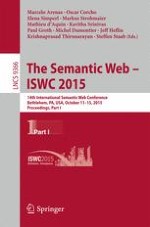The two-volume set LNCS 9366 and 9367 constitutes the refereed proceedings of the 14th International Semantic Web Conference, ISWC 2015, held in Bethlehem, PA, USA, in October 2015.
The International Semantic Web Conference is the premier forum for Semantic Web research, where cutting edge scientific results and technological innovations are presented, where problems and solutions are discussed, and where the future of this vision is being developed. It brings together specialists in fields such as artificial intelligence, databases, social networks, distributed computing, Web engineering, information systems, human-computer interaction, natural language processing, and the social sciences.
The papers cover topics such as querying with SPARQL; querying linked data; linked data; ontology-based data access; ontology alignment; reasoning; instance matching, entity resolution and topic generation; RDF data dynamics; ontology extraction and generation; knowledge graphs and scientific data publication; ontology instance alignment; knowledge graphs; data processing, IoT, sensors; archiving and publishing scientific data; I
oT and sensors; experiments; evaluation; and empirical studies.
Part 1 (LNCS 9366) contains a total of 38 papers which were presented in the research track. They were carefully reviewed and selected from 172 submissions.
Part 2 (LNCS 9367) contains 14 papers from the in-use and software track, 8 papers from the datasets and ontologies track, and 7 papers from the empirical studies and experiments track, selected, respectively, from 33, 35, and 23 submissions.
